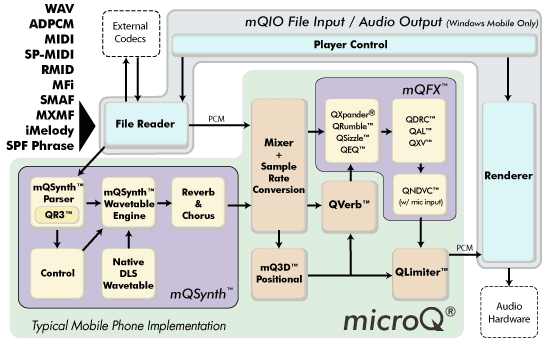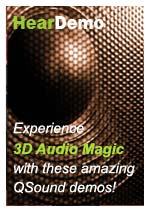 portable digital audio engine
The microQ® / ARM®
Competitive Edge
portable digital audio engine
The microQ® / ARM®
Competitive Edge- Industry leading,
ARM optimised - Proven track record and
established brand recognition - Replaces dedicated hardware
music synthesizer - Single-vendor full audio solution:
- Simplifies integration
- Saves platform resources - Selectable, scalable modular
components for easy implementation - Small memory footprint
- High efficiency processing
- Supports earphones and speakers
- Tunable 3D for all narrow geometry speaker configurations
microQ® / ARM®
for Mobile Devices and Media Players

microQ® is a very compact, hardware-independent and highly efficient software audio engine that enables polyphonic ringtones, 3D game sound and enhanced music playback with numerous audio effects for mobile devices. Modular, scalable components of microQ have been adapted specifically for the ARM® environment, with the requirement for platform specific code simplified to input and output interfaces (API).
microQ® is written in highly-optimized C++ using fixed-point math, featuring the combination of small footprint and high efficiency that is the hallmark of QSound audio platforms. An optional C interface is also available.
Modular, scalable components make microQ readily adaptable to any target
environment, with the requirement for platform-specific code reduced to input and output interfaces.
microQ is currently available for DSP and RISC architectures running Linux, Symbian OS® 7.0s+, Nokia® Series 60, and Microsoft® Mobile.
• ARM7™, ARM9™ and ARM11™ processor families (Optimized by ARM)
QSound's Optimization of microQ®
QSound Labs has done extensive work to optimize its microQ software to achieve one of the most efficient audio solutions in terms of memory footprint and CPU performance. In close partnership with ARM, QSound Labs has undertaken further optimizations of microQ for ARM based environments.
ARM - QSound Strategic Collaboration & microQ® Optimization
ARM and QSound Labs entered into a strategic collaboration to bring industry leading MIDI synthesis, stereo expansion, audio effects, enhancements and 3D positional audio solutions to the wireless market. The partnership includes engineering and marketing initiatives.
From an engineering perspective, ARM has undertaken further optimizations of QSound’s highly regarded and efficient software. The focus of the optimization is centered on the core components of microQ:
- mQSynth™ Polyphonic Wavetable Synthesizer
- mQFX™ Digital Effects
- mQ3D™ Positional 3D Audio Engine
The improvements achieved range from 23 - 40+ percent less mega cycles per second (mcps) using the microQ audio engine on the ARMv5E and ARMv6 architectures.
microQ Product Suite & Corresponding Optimizations
Unmatched by any single vendor, microQ’s modular audio suite consists of the following highly optimized components:
mQSynth™ Polyphonic Wavetable Synthesizer
For ringtones and background music in interactive applications such as games, mQSynth plays musical scores contained in performance files (MIDI or similar formats) using digital sample-based instruments.
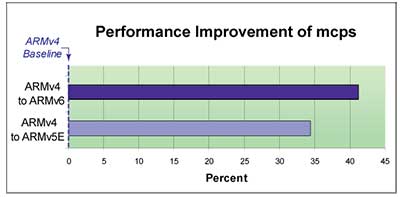
mQSynth performance improvements achieved significant reductions in mega cycles per second (mcps) providing system level resource benefits. The results were:
- 41 percent from ARMv4 to ARMv6
- 34 percent from ARMv4 to ARMv5E.
The industry’s most optimized synthesizer!
mQFX™ Digital Effects
Enhancing the music listening experience, the mQFX suite of digital effects includes:
- QXpander® 3D stereo sound stage expansion.
- QSizzle™ dynamic high-frequency enhancement.
- QRumble™ dynamic low-frequency enhancement.
- QEQualizer™ fully parametric spectrum control with presets.
- QXtremeVolume™ handset speaker volume maximizer.
- QChorus™ effect of multiple instances of a sound source.
- QAutoLeveler™ automatic gain control.
- QNDVC™ noise dependent volume control.
- QDRC™ dynamic range control.
- QLimiter™ anti-saturation dynamic range control.
- QVerb™ digital reverberation.
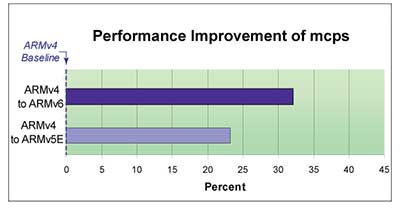
QXpander optimization activity resulted in significant reductions in mega cycles per second (mcps) enabling additional cycles available for utilization by other applications. The results were:
- 32 percent from ARMv4 to ARMv6
- 23 percent from ARMv4 to ARMv5E.
The other effects optimized to similar levels!
mQ3D™ Positional 3D Audio Engine
mQ3D Positional places multiple sounds independently in 3D space for interactive gaming. Applicable to arbitrary streams or mQSynth synthesizer channels using native or custom instruments and sound effects. Optional: QEM® environmental modeling (reverberation).
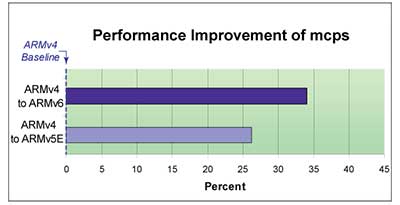
mQ3D optimization produced the following reductions in mega cycles per second (mcps):
- 34 percent from ARMv4 to ARMv6
- 26 percent from ARMv4 to ARMv5E.
With minimized system resources for audio more cycles are available for graphics intensive use cases associated with 3D.
Notes
- The above results have been brought together in collaboration with ARM.
- There is no equivalent correlation between the reduction of MIPS and MCPS, although, a reduction in MCPS has a tangible impact in terms of performance because the code runs more efficiently requiring less use of the processor (minimized system resources). This creates opportunities for better resource utilization for other applications and / or may have an impact in the choice of final clock speed chosen for the system.
